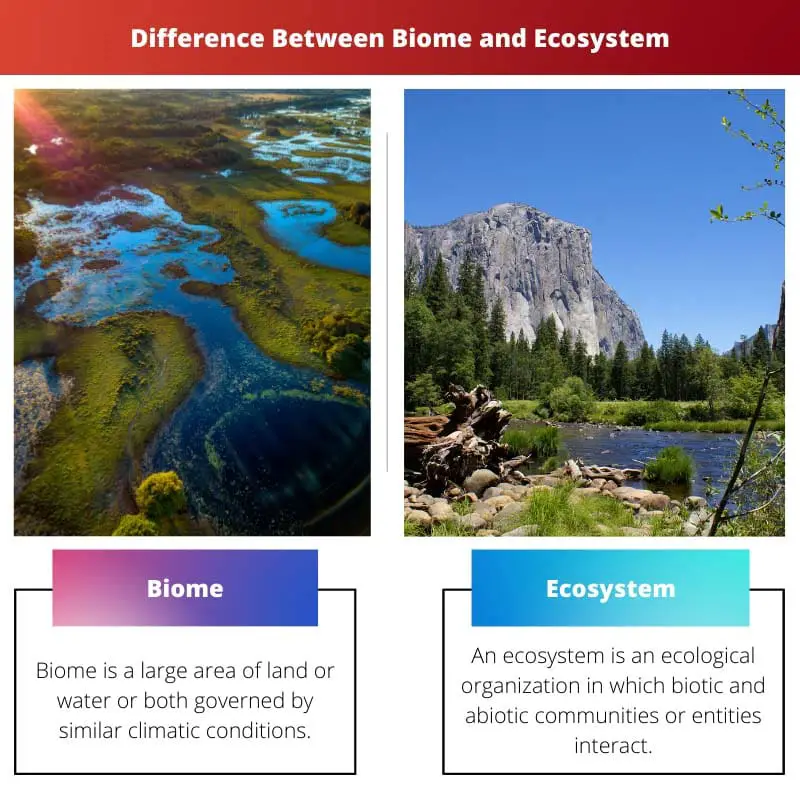The study of biome and ecosystem comes under the branch of biology called Ecology. Ecology is the study of living organisms and their international with their biotic and abiotic environment.
All organisms are arranged and classified into discrete levels of organization. The levels of the ecological organization include individual, population, community, ecosystem, biosphere and biome.
Key Takeaways
- Biomes are large-scale global communities classified by dominant vegetation and climate; ecosystems are localized communities of organisms and their environments.
- Biomes encompass multiple ecosystems that share similar characteristics.
- Climate, precipitation, and temperature primarily define biomes; biotic and abiotic factors shape ecosystems.
Biome vs Ecosystem
A biome is a biogeographical unit comprising a large area characterized by vegetation, soil climate and wildlife. They may span more than one continent. An ecosystem is a biological community of a small area encompassing all the interactions happening between its living and nonliving components.

Biome is a naturally occurring, large geographical area with a distinct climate and plant and animal species adapted to the specific climate. It is the highest level of organization characterized by various abiotic ( climate, pH, light intensity etc.) and biotic factors (flora and fauna).
An ecosystem is an interacting unit of living species with their environment. The various units of the ecosystem, namely the biological community and the abiotic community, interact with each other to form a bubble of life that is self-regulatory.
Comparison Table
| Parameters of Comparison | Biome | Ecosystem |
|---|---|---|
| Meaning | Biome is a large area of land or water or both governed by similar climatic conditions. | An ecosystem is an ecological organization in which biotic and abiotic communities or entities interact. |
| Size | Biomes are comprised of a large geographical area. | Ecosystems are comparatively smaller geographical areas and may be as small as a fish tank. |
| Climate | Biomes are classified according to the climate prevailing in the area and how it affects the organisms living in it. Hence climate governs the biomes. | Ecosystems are not governed and classified according to the climate of the area. |
| Interaction of comprising units | All units in a biome may or may not interact with each other due to large distances between them. | All units of an ecosystem interact with each other as they are closely related and interlinked. |
| Made of | A large number of ecosystems form biospheres. Many biospheres form a biome. | Ecosystems are made of various species communities interacting with each other and their environments. |
| Latitude | Biomes are affected by latitude as latitudinal positions affect the temperature, rainfall and climate of an area. | Ecosystems are not affected by latitude. |
| Examples | The savannas, tundra, taiga, wetland forest are some examples of biomes. | A pond ecosystem, a forest ecosystem are some examples of ecosystems. |
What is Biome?
The term biome was first suggested by Clements, which meant “geographical province”.
Biome is a large geographical area with its distinct climate and organisms adapted to that particular climate. In simple terms, it’s a large piece of land or water between a latitudinal difference where the climate remains the same.
Various ecosystems exist in a biome. A large variety of organisms also coexist in a biome. It is, however, not necessary that each unit, if a biome, interacts with each other.
Biomes consist of biota, which means the total number of organisms present in a geographical region or time period. As the area under consideration is large, the biota of a biome is practically huge, comprising related and non-related organisms.
According to Allee (1949), terrestrial biome types are :
- Tundra
- Taiga
- Deciduous forest
- Grasslands
- Desert
- High plateaus
- Tropical forest
- Minor terrestrial biomes
Even aquatic biomes are divided into freshwater and marine biomes. The marine biome is the largest present biome in the world.

What is Ecosystem?
An ecosystem is a self-regulatory, interconnected, interactive unit of organisms and their non-living environment. It studies their interrelation. Each unit of an ecosystem directly or indirectly interacts with each other through trophic levels or food webs.
Ecosystems are not climate centric. Rather, they are defined by geographical definitions. Thus latitude also does not matter.
Ecosystems may be small or large. An artificial fish tank is also an ecosystem, while a tropical rainforest is also an ecosystem with organisms and food web characteristics.
The structure of an ecosystem depends on its biotic and abiotic components. Each ecosystem differs from the other by the structure of these components.
Ecosystems are broadly classified into:
- Natural Ecosystems like pond ecosystems, river ecosystems, forest ecosystems, and marine ecosystems.
- Artificial Ecosystems like artificial ponds, fish tanks or even rotting wood logs.
Natural Ecosystems themselves can be divided into:
- Aquatic Ecosystem
- Terrestrial Ecosystem

Main Differences Between Biome and Ecosystem
- Biome is a naturally occurring geographical area, while ecosystems can be natural or artificial.
- Biomes are comparatively larger areas of landmass or water bodies grouped based on some physical factor, mostly climate and latitude. Ecosystems, on the other hand, are smaller areas of interactive organisms and their immediate environment.
- Many ecosystems make up a biome, while many living communities and their environments make up an ecosystem.
- In a biome, each organism doesn’t need to interact with each other as they are separated by large distances and other physical barriers. In ecosystems, all organisms are closely related and work together to form self-regulatory units or trophic levels and food webs. Usually, animals adapted to the same ecological condition and having interlinked niches exist in an ecosystem.
- Biomes are classified according to their climate, while ecosystems are classified according to their interacting biotic and abiotic entities.

- https://link.springer.com/content/pdf/10.1007/BF02861083.pdf
- https://onlinelibrary.wiley.com/doi/abs/10.1111/j.1365-2486.2006.01239.x
- https://esajournals.onlinelibrary.wiley.com/doi/abs/10.1890/09-1552.1

The concept of biomes and ecosystems is fascinating. The vast differences between them are well-explained in the article. It’s interesting how biomes are affected by latitude while ecosystems are defined by geographical boundaries.
Agreed. The article effectively conveys the complexity and unique aspects of both biomes and ecosystems. The table comparing the parameters of each is particularly helpful.
The section detailing the differences between biomes and ecosystems is particularly insightful. It highlights the various parameters that distinguish these ecological concepts.
The comparison table effectively highlights the distinctions between biomes and ecosystems, providing a clear and structured presentation of their differences. It greatly enhances the clarity of the article’s content.
Absolutely, the comparison table serves as an invaluable tool in elucidating the contrasting features of biomes and ecosystems, contributing to the overall depth of the article’s content.
The article provides an in-depth exploration of biomes and ecosystems, shedding light on their ecological roles and differences. It’s an engaging and informative read.
Indeed, the content is rich and well-researched. It’s evident that the author has a deep understanding of ecological concepts and has effectively communicated them to readers.
The distinction between biomes and ecosystems is essential in understanding ecological systems. The clarity in defining each concept and their characteristics in the article is commendable.
Certainly, the article provides an insightful overview of biomes and ecosystems. The comparison table effectively highlights the differences between the two ecological entities.
The study of biome and ecosystem comes under the branch of biology called Ecology. Ecology is the study of living organisms and their international with their biotic and abiotic environment. All organisms are arranged and classified into discrete levels of organization. The levels of the ecological organization include individual, population, community, ecosystem, biosphere and biome. Biomes are large-scale global communities classified by dominant vegetation and climate; ecosystems are localized communities of organisms and their environments. Biomes encompass multiple ecosystems that share similar characteristics. Climate, precipitation, and temperature primarily define biomes; biotic and abiotic factors shape ecosystems. A biome is a biogeographical unit comprising a large area characterized by vegetation, soil climate and wildlife. They may span more than one continent. An ecosystem is a biological community of a small area encompassing all the interactions happening between its living and nonliving components. Biome is a naturally occurring, large geographical area with a distinct climate and plant and animal species adapted to the specific climate. It is the highest level of organization characterized by various abiotic ( climate, pH, light intensity etc.) and biotic factors (flora and fauna). An ecosystem is an interacting unit of living species with their environment. The various units of the ecosystem, namely the biological community and the abiotic community, interact with each other to form a bubble of life that is self-regulatory. Biomes are affected by latitude as latitudinal positions affect the temperature, rainfall and climate of an area. Ecosystems are not affected by latitude.
I appreciate the detailed explanation about the key takeaways and the comparison table between biomes and ecosystems. It provides a clear understanding of the two concepts.
Absolutely, the differentiation between biome and ecosystem is crucial in understanding the dynamic interactions between living organisms and their environment.
The article’s detailed elaboration on biomes and ecosystems is both comprehensive and accessible. It’s evident that the content is well-researched and contributes to a deeper understanding of these ecological concepts.
Agreed. The article serves as an insightful resource for anyone seeking to enhance their knowledge of biomes, ecosystems, and their ecological dynamics.
The detailed explanation of what constitutes a biome and an ecosystem is enlightening. The examples and comparison table add depth to the understanding of these ecological concepts.
I agree. The article offers a comprehensive examination of biomes and ecosystems, enhancing our knowledge of the natural world.
Absolutely, the article’s content effectively captures the complexity and significance of biomes and ecosystems within the field of ecology.
The thorough exploration of biomes and ecosystems in the article is engaging and intellectually stimulating. The content is presented in a manner that invites readers to delve deeper into the world of ecology.
I concur. The article provides a thought-provoking analysis of biomes and ecosystems, fostering an appreciation for the intricate relationships between living organisms and their environments.
Absolutely, the article serves as a captivating delve into the realms of ecology, offering rich insights into the ecological dynamics of biomes and ecosystems.
The article offers a comprehensive overview of biomes and ecosystems, illuminating their distinct characteristics and ecological significance. The comparison table is a valuable visual aid in understanding the differences between these entities.
I concur. The comparison table effectively summarizes the key differences between biomes and ecosystems, enhancing the reader’s understanding of these ecological concepts.
Absolutely, the article provides a well-rounded exploration of biomes and ecosystems, unraveling the complexity of these ecological entities.